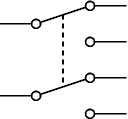| Component | Circuit Symbol | Function of Component |
| Push Switch (push-to-make) | A push switch allows current to flow only when the button is pressed. This is the switch used to operate a doorbell. | |
| Push-to-Break Switch | This type of push switch is normally closed (on), it is open (off) only when the button is pressed. | |
| On-Off Switch (SPST) | SPST = Single Pole, Single Throw. An on-off switch allows current to flow only when it is in the closed (on) position. | |
| 2-way Switch (SPDT) | SPDT = Single Pole, Double Throw. A 2-way changeover switch directs the flow of current to one of two routes according to its position. Some SPDT switches have a central off position and are described as 'on-off-on'. | |
| Dual On-Off Switch (DPST) |  | DPST = Double Pole, Single Throw. A dual on-off switch which is often used to switch mains electricity because it can isolate both the live and neutral connections. |
| Reversing Switch (DPDT) |  | DPDT = Double Pole, Double Throw. This switch can be wired up as a reversing switch for a motor. Some DPDT switches have a central off position. |
| Relay |  | An electrically operated switch, for example a 9V battery circuit connected to the coil can switch a 230V AC mains circuit. NO = Normally Open, COM = Common, NC = Normally Closed. |
This site contains a lot of Free E-Books and all information about Electronics Enginering, EBooks, Algorithms, Software Books & Complete Micro Processor Guide
Wednesday, February 13, 2008
Switches symbols
Subscribe to:
Post Comments (Atom)
No comments:
Post a Comment